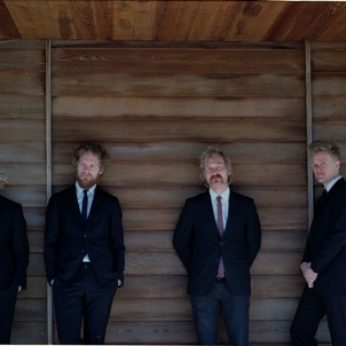Composer: Johannes Brahms (b. 1833 - d. 1897)
Performance date: 04/07/2014
Venue: Bantry Library
Composition Year: 1891
Duration: 00:38:06
Recording Engineer: Richard McCullough, RTE
Instrumentation Category:Clarinet Quintet
Instrumentation Other: cl, 2vn, va, vc
Artists:
Danish Quartet (Frederik Øland, Rune Sorensen [violins], Asbjørn Nørgaard [viola], Fredrik Sjölin [cello]) -
[quartet]
Julian Bliss -
[clarinet]

If ever a justification was needed for a music festival, then the story
of Brahms’ meeting with Richard Mühlfeld provides it. After writing his Opus
111, Brahms had been threatening to retire from composition: Above all I was always used to everything
being clear to me. It seems to me that it’s not going the way it used to. I’m
just not going to do any more. My whole life I’ve been a hard worker; now for
once I’m going to be good and lazy! His visit to the week-long festival at
Meiningen changed all that. Brahms was stunned by performances of the Weber
Clarinet Concerto and Mozart Clarinet Quintet by Mühlfeld. Here was a musician
who could make his instrument sing like a violist or mezzo-soprano – other
incarnations of the dark, soulful voice that had always seduced him. He sat
with him for hours listening to him play and was spellbound by the sensuality
of the clarinet in Mühlfeld’s hands. The fruits of that summer’s composing were
first the Clarinet Trio and then, what he called a far greater folly, the B minor quintet.
Traditionally the solo instrument is set
against the strings in a solo-versus-tutti
confrontation, but Brahms finds a subtler way to unveil the glory of his new
love. After the haunting introductory measures for strings alone, the clarinet
gradually emerges, only to sink back into the string texture, emerge again,
then once again be re-absorbed. Even the customary opposition between major and
minor, so crucial to expression in tonal music, is eroded, so we are left in
the ambivalent world of dreams. Almost all the first movement themes are
gentle, relaxed and reflective except for the staccato and forceful transition
from the first to second subject and a brief display of passion in the coda.
Much has been made of this work’s autumnal resignation, but it is just as
likely that Brahms was joyfully exploring this new rich, velvety voice he had
so belatedly discovered.
This late-night romance reaches its
apotheosis in the ternary form adagio, evoking a profound mood of sensuous
longing. It is a song of love, whose sweet sighs are unique to the clarinet.
The long piú lento central section is
Brahms’ last homage to the Zigeuner
style, with a series of florid clarinet arabesques that spiral and swoop over a
fantastic string texture of rustling tremolandi.
The brief scherzo begins with an ambling
andantino, whose serenade-like cadences soon give way to a Presto non assai ma con sentimento.
This turns out to be the main portion of the movement, developing its
own self-contained sonata form and generating a burst of energy before
subsiding in a quiet glow. The finale is a set of variations just like the last
movement of Mozart’s Clarinet Quintet.
The theme is followed by five variations and a coda, handled with all
the marvellous harmonic resource of Brahms’ later manner. The tune itself seems
to reflect much of the material we have already heard and the variations
themselves underline this cyclic idea. The agitated second variation clearly
alludes to the gypsy arabesques of the slow movement, and the fourth variation
recalls the presto theme from the third movement. The final variation takes on
the form of a passionate waltz, leading without a close straight into the coda.
This begins in a sombre mood and quotes both the opening and the closing of the
first movement, with subtle hesitations and an unexpected stress at the very
end that hints at the coming of winter.
Copyright © 2025 West Cork Music. All rights reserved.
Designed and developed by Matrix Internet